Shetland Islands: 30 Amazing Things To Do
Shetland is a small set of islands located in the north of Scotland. This post lists the best things to do in the Shetland Islands.
There are so many activities to do all year round; the only thing that is not guaranteed is the weather.
Make sure you pack enough for all four seasons and go outside and explore the beautiful islands. The Shetland Islands are home to 1,697 miles of spectacular coastline.
Shetland is a must-go place for an off-the-beaten-track experience, with over a hundred islands to explore.
Only 15 of the islands are inhabited. Altogether there is a population of 23, 000 people.
There are some excellent walking routes on the Shetland Islands. With the mesmerising coastal scenery of the North Sea and Atlantic-facing cliffs, the island has arguably some of the best sights in Europe.
You can admire quiet inland lochs and sprawling, heathered hills as well as amazing coastal scenery and high cliffs.
Shetland is a group of islands. Some islands are close to the mainland and can be reached by car.
The islands near Shetland include Isle of Noss, Fair Isle, Mousa, Ust, Papa Stour, Yell and Fetlar.
Getting There
To get to Shetland, you can enjoy the overnight ferry from Aberdeen. The ferry from Aberdeen leaves at 7 pm, makes a late night stop at Orkney and then arrives in Lerwick at 7 am.
The cabins are small and cosy. Also, on board, there is a cinema, a choice of restaurants and a shop which sells local produce.
In addition, flights are available from the mainland to one of Shetlands airports.
Flying is the quickest way to get to Shetland. You will get amazing views as you approach Sumburgh Airport.
Sumburgh Head Lighthouse, Visitor Centre and Nature Reserve
Sumburgh Head is a magical area located on the Southern tip of the Shetland mainland.
Here you can learn about the history and natural heritage of Sumburgh Head, from the geological period to the Iron Age settlers. Also, outdoor plaques tell you about the lighthouse and its history.
The views are amazing! There is a wide range of wildlife, including puffins and whales.
The coffee shop and visitor centre are open daily from April to September.
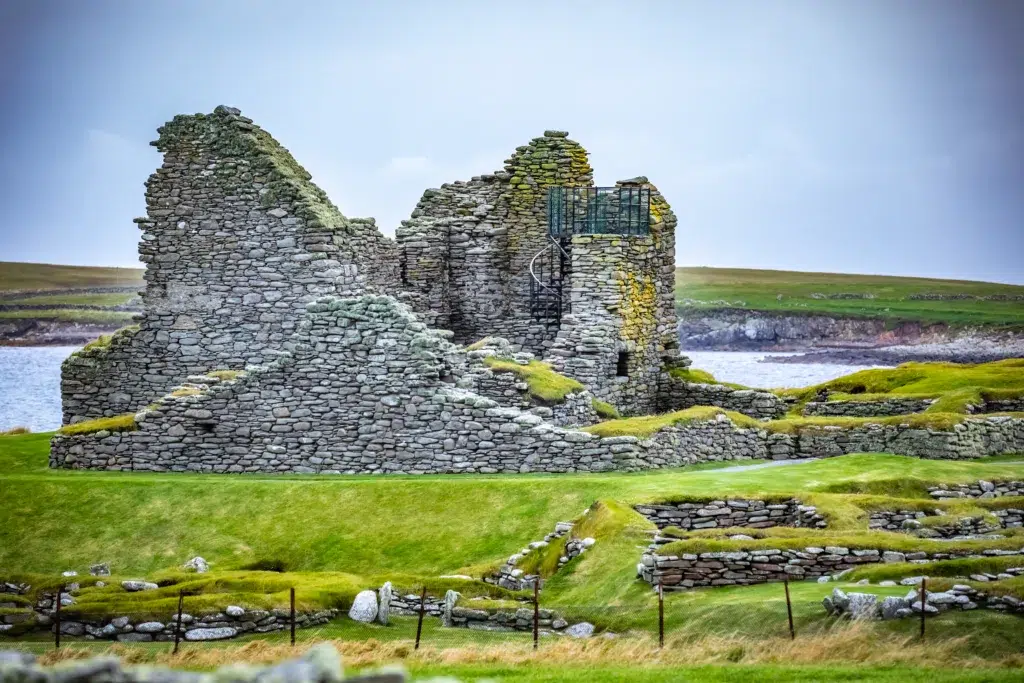
Jarlshof Pre Historic and Norse Settlement
Jalfshof is located a mile southeast of Old Scatness. The Pre Historic and Norse Settlement has over 4,000 years’ worth of history.
It is believed that the settlement has been around for 1,400 years and dates back to the Neolithic period in the 1600s AD.
There are impressive remains from the Bronze Age, Iron Age, Viking and mediaeval periods. Neolithic communities first occupied the patch of land until the 17th century.
Jarlshof is Shetland’s answer to Skara Brae – the UNESCO World Heritage Site in Orkney. Overlooking the West Voe of Sumburgh, the site’s location is vulnerable to ferocious storms.
At the visitor centre, you can look at the exciting artefacts that have been unearthed at the site.
At the site, you can find Bronze Age houses, Iron Age broch and wheelhouses, Norse long houses, a medieval farmstead and a laird’s residence from the 16th century.
This excellent historic site has a visitor centre. The entry price for adults is £7, and you get a free audio tour.
Historic Environment Scotland currently manages the site.
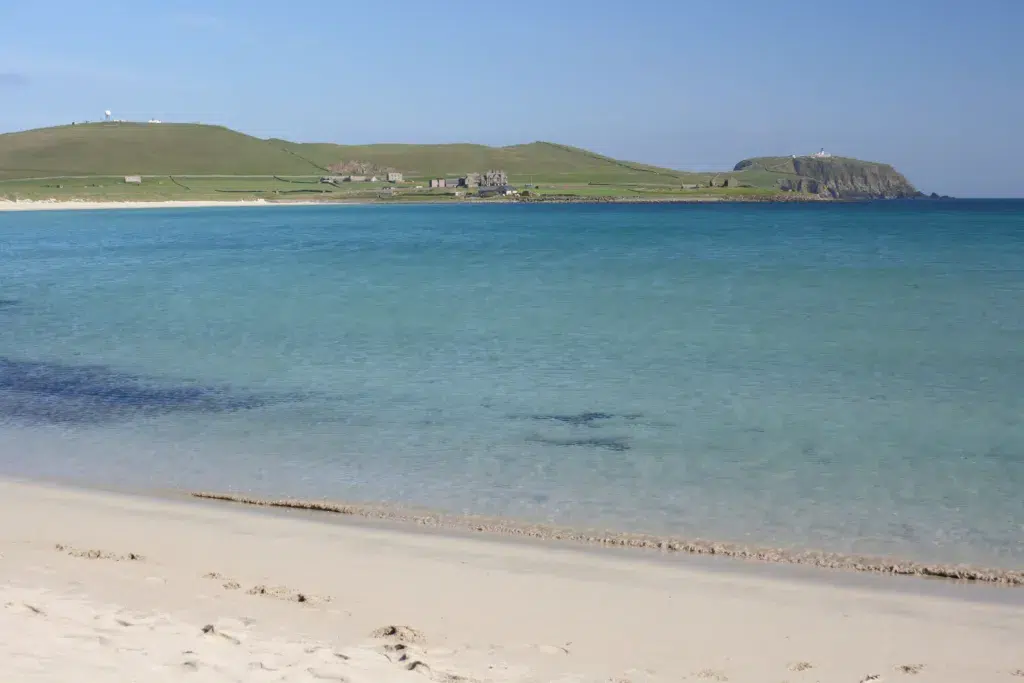
West Voe Beach
West Voe Beach is located between Jarlshof and Old Scatness, just opposite the airport. The beach is a beautiful spot, with white sands and green water.
As well as marvellous views across the airport, you can also see the Sumburgh lighthouse. On a clear day, you might be able to catch a glimpse of Fair Isle.
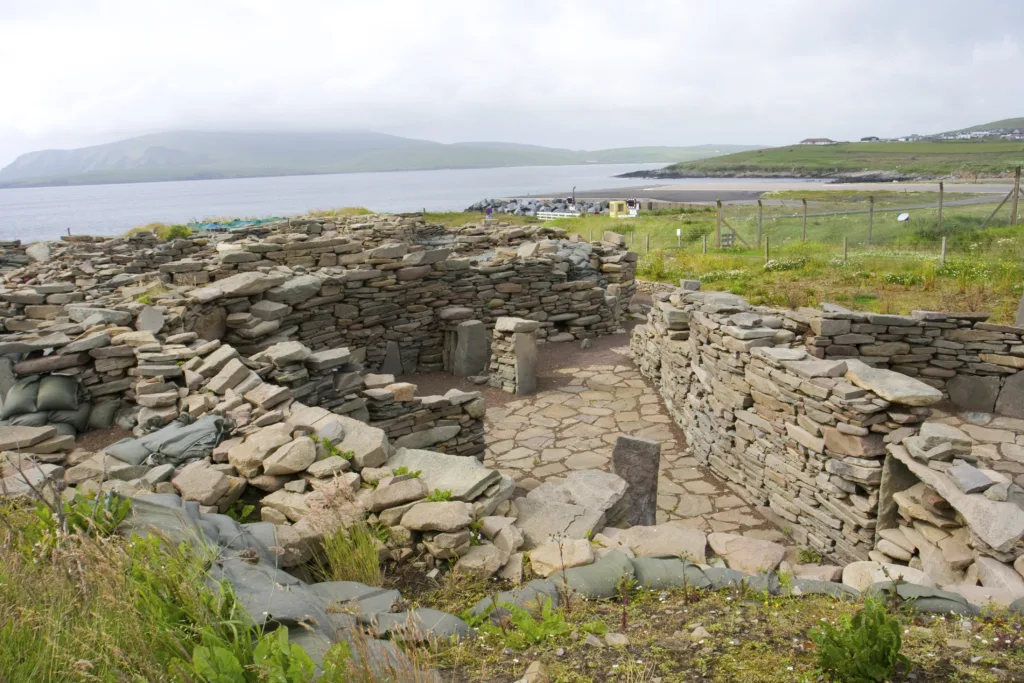
Old Scatness Broch & Iron Age Village
During the construction of roads and the airport in 1975, the Old Scatness was accidentally uncovered and excavated in the late 1990s.
It is believed that the old broch from Old Scatness dates back between 400 BC and 200 BC, and an Iron Age village tightly surrounds it.
It is believed that the Vikings and the Pictish people later adapted the structures. Again, this is another great time capsule that represents how people used to live in the Shetland islands.
Shetland Croft House Museum
The Croft House Museum shows what it was like to live in a 19th-century croft house.
The restored home features a thatched roof, peat fire, box beds and a traditional Shetland mouse trap.
The earthy peat smell hits you as you walk in, and it is an excellent way to learn about how people used to live.
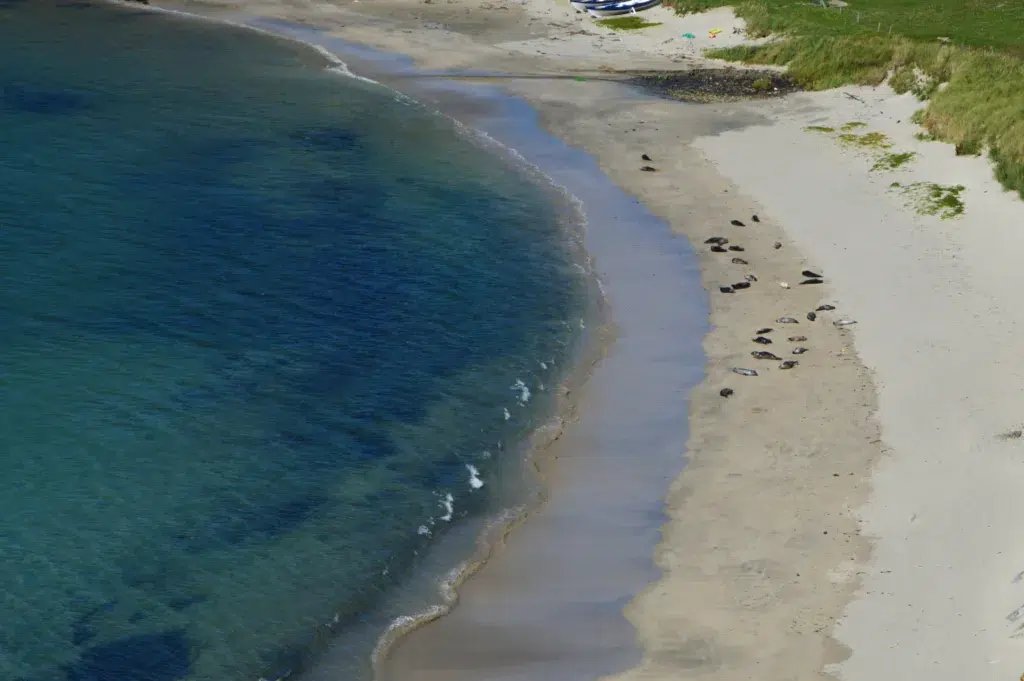
Spiggie Beach
Spiggie Beach is a lovely beach you will likely have to yourself when you are there. The beach is a gorgeous white sand beach with seals and seabirds.
The beach is easy to access with a small car park nearby. Overall, this is the best beach in the south end of Shetland, with fine clean sands.
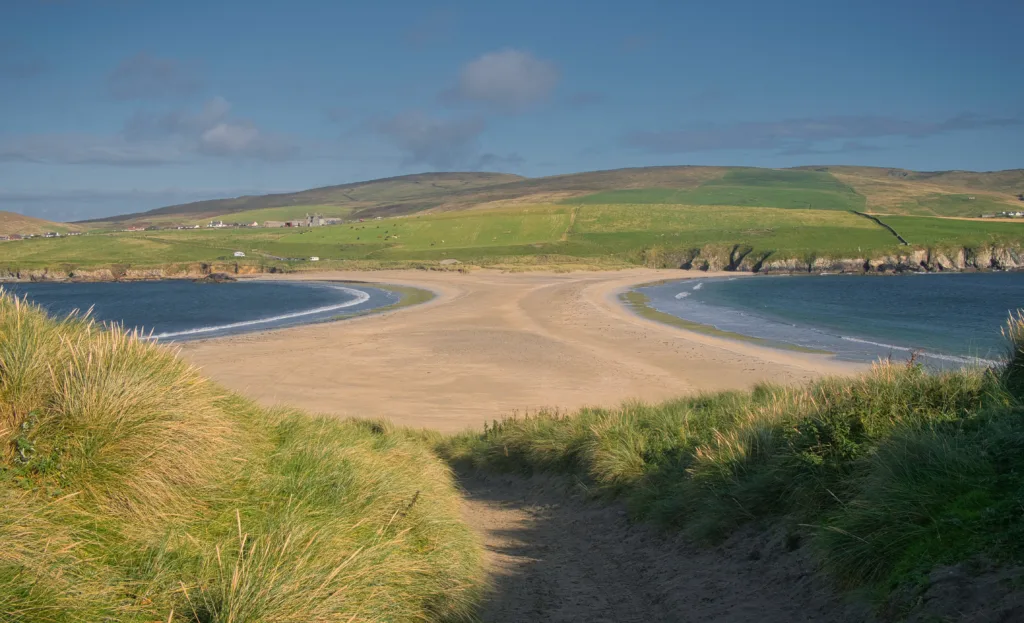
St Ninian’s Isle
St Ninian’s Isle is a small part of the land connected to the mainland by the famous sandy tombolo. The tombolo is the largest shell and the sand tombolo in Britain.
St Ninians Beach is one of the best beaches on the islands of Scotland.
There is a chapel on the east-facing slopes of the island. In 1958, a schoolboy was helping with the excavation of the site.
During this time, he found Pictish silverware, jewellery, bowls and weapons, which were believed to be hidden from the Viking invaders.
At the Shetland Museum, you can find replicas of the treasures. Also, at the National Museum of Scotland in Edinburgh, you can find natural gems that were discovered.
You can visit the chapel anytime but be aware of the tides as the tombolo can be flooded. Entry for adults costs £3.50.
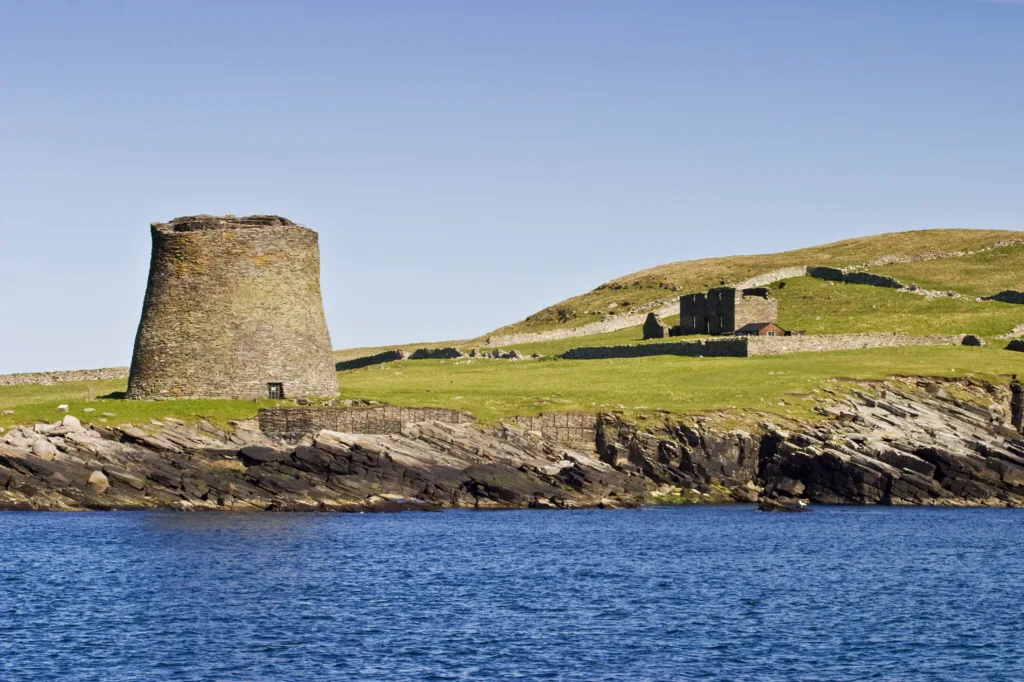
Mousa Iron Age Broch
The Mousa Broch is located on the Island of Mousa, a small uninhabited island. Mousa Iron Age Broch is Scotland’s best-preserved broch.
It will take approximately two hours to walk around the main section of the island. Ferries are available from Sandsayre.
Here, you can climb the stairs and stand on the wellhead which is 13 metres high. It is believed that the broch was built in 300 BCE.
The Island of Mousa is also known as a breeding place of the largest colony of Europe’s smallest seabird, the Storm Petrels. The Storm Petrels nest in the broch walls to protect themselves from predators.
To get to Mouse Broch on the Island of Mousa, you can catch a ferry from the hamlet of Leebritton. Entry to the broch itself is free. However, there is a fee for the ferry.
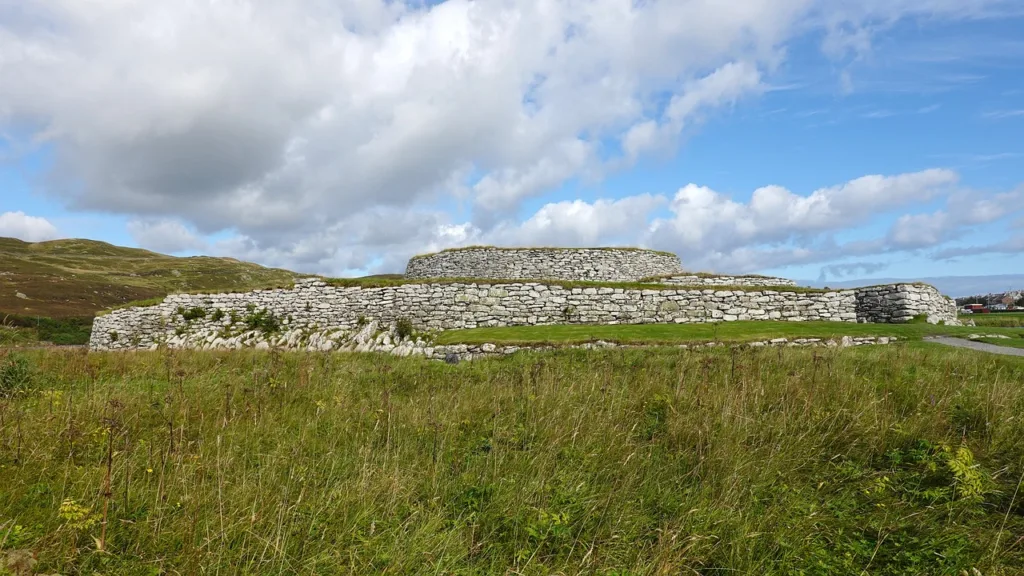
Clickimin Broch
On Clickimin Loch in the heart of Lerwick, you will find Clickimin Broch. Clickimin shows that there was a settlement spanning over a thousand years.
The broch is surrounded by other buildings and is believed to date back to the bronze age. Also, it is believed to have ties to kingship and inauguration rites. Historic Environment Scotland currently manages the site.
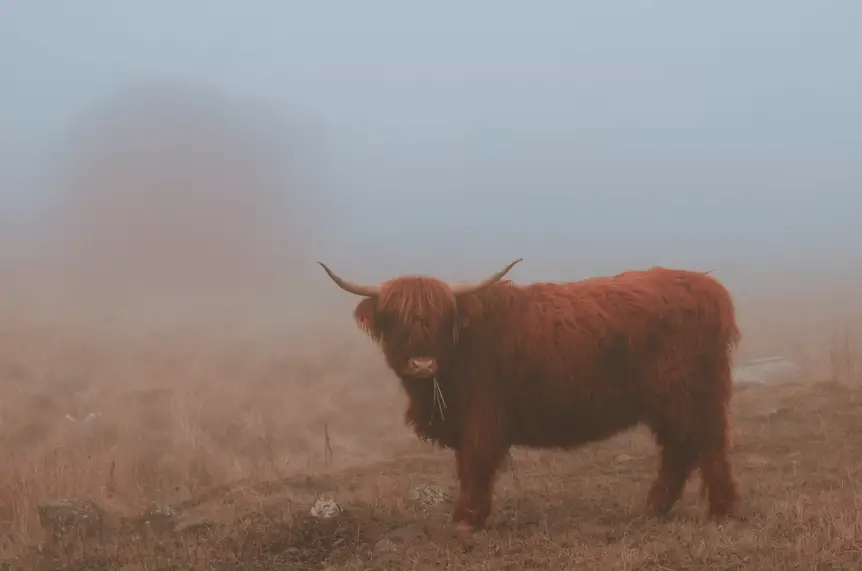
Shetland Museum
Shetland Museum has a lot of information regarding the history of Shetland.
Galleries and exhibits show the best geology, archaeology, customs and maritime heritage over the past 5,000 years. Also, you can learn more about the fishing industry and local mythology.
The Boat Shed is a fantastic boat-building workshop where you can watch boats getting fully restored. Also, you can view some delicate items such as Pictish carvings and replica jewellery.
Moreover, the museum includes a working lighthouse mechanism, a small gallery and an archive for tracing Shetland ancestry. Hay’s Dock Café Restaurant provides a delicious menu.
Peerie Shop Cafe
Peerie translates to wee or small in the Shetland dialect. The Peerie Shop Café is a converted lodberry which serves homemade cakes, scones, soups, sandwiches and treats.
The coffee shop is just next to the harbour, right in the middle of Lerwick. It is an excellent place to go for breakfast.
Isle of Noss
Little Noss is just north of Bressay and is 1.5 miles wide. The island features high sea cliffs, which are home to 100,000 pairs of breeding seabirds.
Walking around Noss anti-clockwise is more accessible and provides spectacular views of the cliffs and surrounding area.
The Isle of Noss can be reached by a ferry from Lerwick to Bressay and by following signs to Noss. Also, by the dock, there is a small visitor centre.
The Noss ferry runs throughout the summer. The ferry fare for adults is £5.
Noss National Nature Reserve
Noss National Nature Reserve has one of the greatest wildlife sites in all of Europe.
The six-mile-long trail includes outstanding cliffs which are 180 metres tall. There is a visitor centre where you can learn about birds, geology and wildflowers.
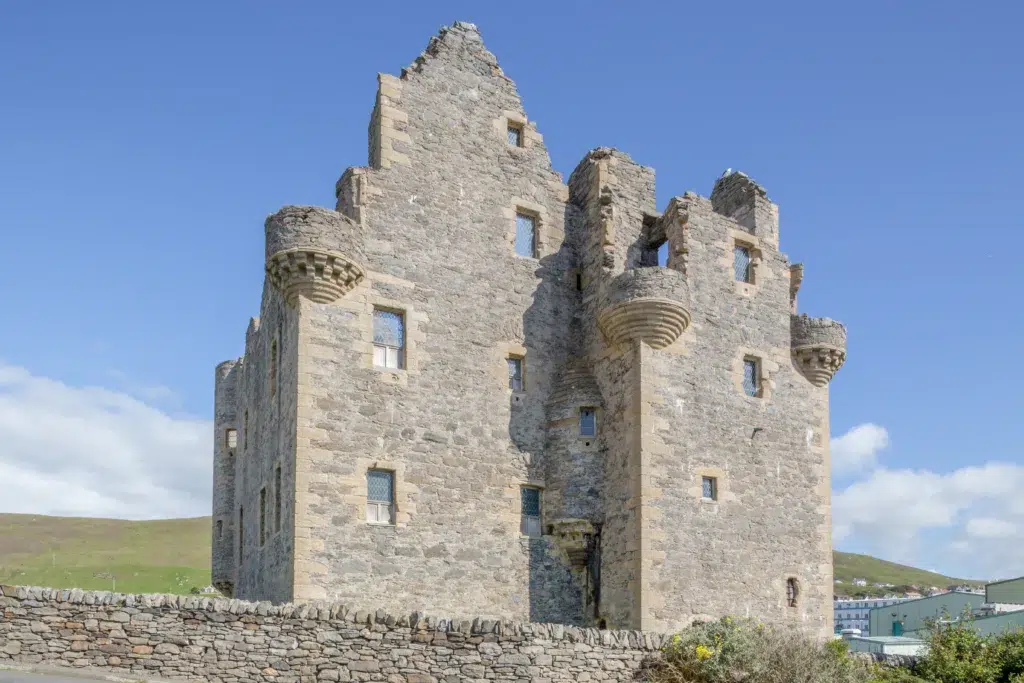
Scalloway Castle
Scalloway Castle is a ruined castle located in the ancient capital of Shetland. The castle was built in the 15th century and is one of the only two castles built in Shetland.
Patrick Stewart was the Earl of Orkney and Shetland and was the owner of the castle. He had a poor reputation and was well known for his oppression of the Shetland People.
The castle is riddled with drama and bloodshed. Admission to the castle is free. Historic Environment Scotland currently owns the site.
Scalloway Museum
The museum is next door to a castle. Here, you can view the excellent exhibit about the Shetland Bus, which played an essential role in supporting Norway in World War II. Also, there is a lovely exhibit on knitting on the Isle.
Shetland Pony Experience
The Shetland Pony Experience is located in Bridge-End in Burra. There are tours available which cost £30, and it lasts an hour.
The price includes tea or coffee at the end. Also, you can talk to the owners to learn more about the ponies.
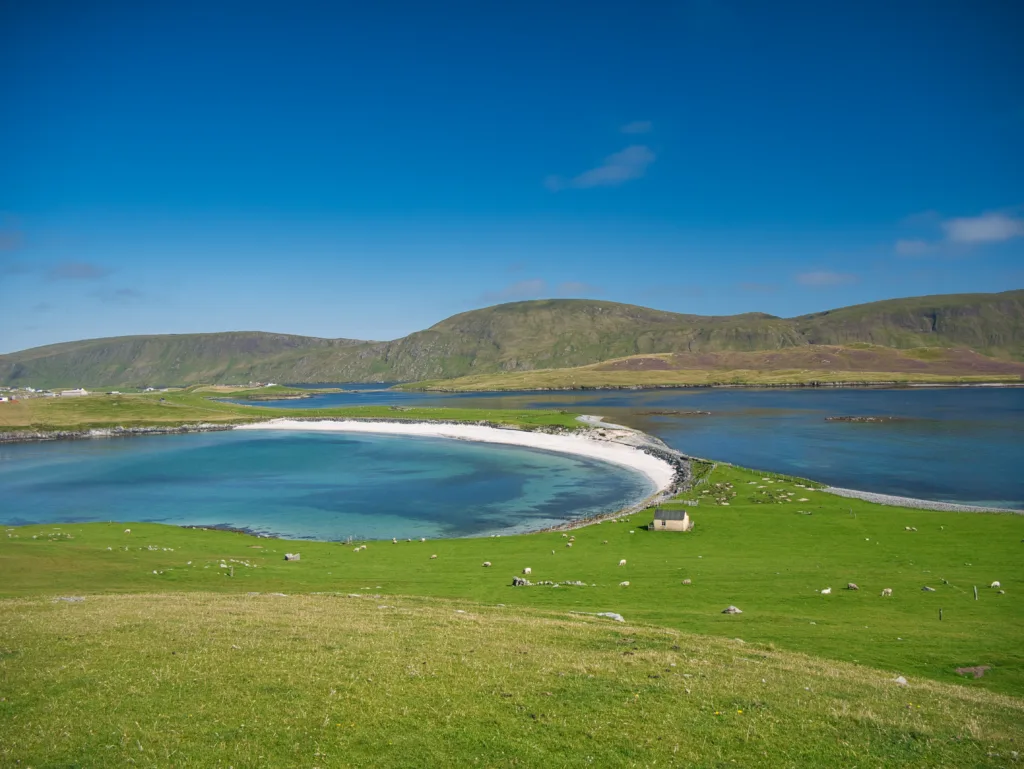
Minn Beach
Minn Beach is unique as it is a tombolo with two completely different sides.
One side has white sands and bright blue water, while the other has dark water and a gravel beach.
The parking for the beach is quite limited, and the walk back to the car park is steep.
Abandoned Building at Weisdale
At a small peninsula on the western shore of Weisale Voe is a ruined house and the ruins of Old Lady Chapel. The chapel is located in a sacred place which was used to refuge sailors during storms.
Women often left gifts in exchange for a wish. This is believed to be a ritual in Christian society.
Next to the bay and small ruined chapel is the derelict remains of the Clunies-Ross family home. Wealthy merchants, landowners and lairds lived in these large houses in Shetland back in the 18th century.
Interestingly, the Clunie-Ross developed their currency using tokens. Descendants of John Clunies-Ross from the Sound still live and work on the island today.
Park Hall
Park Hall is a building which has been abandoned and has been left to ruin. The classic two-storey and three-bay house was made from poured concrete.
You can find the ruin in Shetland’s West mainland, and it sits just off the road to Walls (A971), just a few miles west of Baxter.
Papa Stour
There are just a handful of permanent residents that live on Papa Stour. The small island is located on the west of Shetland mainland.
Papa Stour is a beautiful place where you will be impressed by the magnificent coastlines. The island’s west coast is stunning with phenomenal cliffs, stacks and caves.
One of the most impressive geological formations is the Kirstan’s (or Christie’s) Hole, a huge tunnel under the coastline.
You can look into the cave through a hole at the top of the cliff. A small loch collapsed into the roof of the cave in 1981.
To get to the peaceful haven, you can get a ferry from West Burrafirth, which will take 35 minutes. Check the Shetland Island Council ferry timetable for more information.
Once you have arrived at the small island, you can witness a partial reconstruction of a stofa. A stofa is a Scandinavian building where wealthy Norse farmers lived centuries ago.
Also, while you are there, you can visit the Commonwealth War Grave and Papa Stour Kirk.
Frankies Fish and Chips
Back on the mainland, you can find Frankie’s Fish and Chips. Frankie’s Fish and Chips has award-winning seafood which is locally sourced. There is a takeaway and seating area.
The fish and chip shop was officially the best British fish and chip shop in 2015. I recommend getting the honey and chilli mussels, pan-fried scallops in cream sauce, or classic battered fish and chips.
The service is outstanding, with polite and excellent staff.
Muckle Roe
Hams of Muckle Roe Circular is a challenging walking route which will take six hours to complete. The Hams of Muckle Roe translates from Old Norse as the Havens of the Big Red Island.
The walking route begins at the end of the road at Little-Ayre. Also, the circular route is located on an island which you can drive to from the Shetland mainland.
One of the first stops on the walking routes is a beautiful secluded red beach. From here, you can follow the signs to the lighthouse.
The path has many beautiful views of caves, stacks and the Holes of Hellier. Also, you can enjoy the view out to Vemetry with its First World War guns on the headland of Swarbacks Head.
After viewing the lighthouse, you can follow the less-defined paths and view the impressive sea stacks known as ‘The Spindle’. Next, you can visit the town of South Ham before following the route back to Little-Ayre.
Cliffs of Ehaness
The Cliffs of Ehaness are a fantastic sight on the north of Shetland mainland.
The cliffs were formed by the blast of volcanoes millions of years ago and are one of the many reasons Shetland is a UNESCO geopark.
Also, the volcanic cliffs were formed 420 million years ago when colliding continents created the supercontinent.
Isle of Fetlar
Fetlar is a small island northeast of Shetland, south of Ust and east of Yell. The island has been known as the ‘Garden of Shetland’ since the Norse times due to to the fertile lands and stunning landscapes.
The island is home to 60 residents. Fetlar has abundant wildlife, stunning scenery and a small but friendly community.
The journey from Yell is 25 minutes and the Brough Lodge is just a few miles from the ferry terminal.
Brough Lodge
Brough Lodge is located in Fetlar, which is the last of the three isles north of Shetland mainland. Brough Lodge is a Georgian Gothic-style building.
At the time the house had a drawing room, library, butler’s pantry and counting room. Also, the building hosted an astronomical observatory.
The building was occupied until the 1970s, now is lying in disrepair.
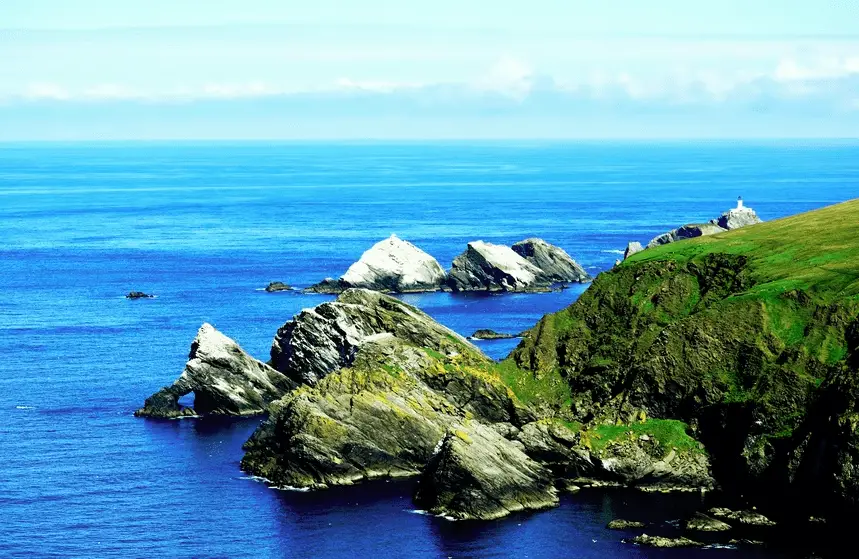
Unst
Unst is the northernmost island of Shetland. It has wildlife, heritage and the northernmost brewery and distillery in the United Kingdom.
To get to the islands, you will have to take two ferries, so it is a bit of a road trip to get there.
Muness Castle
The second castle of Shetland is located on the northern island of Unst. Muness Castle was built in the late 16th century. The castle has fine architecture, including turrets and dummy gun loops.
The castle was occupied until the 18th century. Then it was sold off to the Bruce family and fell into ruin.
Muness Castle is free to visit and is open all year round. Historic Environment Scotland currently manages the site.
Bobby’s Bus Shelter
A famous bus stop on the northern most inhabited island in the UK is usually decorated. The shelter is decorated differently for upcoming events such as Christmas, the Queen’s Jubilee and Easter.
It is a charming piece of folk art expressionism which is humorous, colourful and light-hearted. It is worth the stop for the photo.
Hermaness National Nature Reserve
Hermaness Healand has a beautiful 4.5 miles round walk which takes you on a tour of the cliffs where you can spot puffins, fulmars, gannets and guillemots.
The cliffs are located an hour’s walk from the car park. To get to the cliffs, you have to follow gravel paths and a boardwalk, along a stunning peatland with heather, crowberry, cotton grass, mosses and other vegetation.
Also, you can see Scotland’s most northerly point, the rocks of Out Stack and Muckle Flugga, with a lighthouse. This is one of Scotland’s most stunning national nature reserves.
Hermaness is like walking to the edge of the world. The Muckle Flugga lighthouse mostly dominates the area.
Craft Trail
Visit craft workshops and open studios, where I could speak with locals about their lives in Shetland. A map is available here.
Fair Isle
Fair Isle is a jewel of an island located halfway between Orkney and Shetland. To get to the island, you can pre-book a ferry which takes 2.5 hours.
Alternatively, you can get a flight that takes 25 minutes and operates from April to October.
Fair Isle is a fantastic place to explore. There is a museum, bird observatory, lighthouse and many walking trails.
Clavel
There are house ruins at Clavel, which is a few miles south of Nigton in Shetland’s south mainland.
The ruins are of croft houses which were traditional in Shetland right into the 20th century. The houses were tiny, compact, draughty, damp and crowded.
Is Shetland Worth Visiting?
The Shetland Islands is a perfect destination if you want to get away from the busy city life, and into a safe, calming haven. Shetland is a unique island with breath taking cliffs, neolithic landforms, stunning beaches and amazing wildlife.
The islands are the most northerly area of the UK in a superb location between the Atlantic Ocean and the North Sea. You may get the opportunity to witness an orca chase, otters, dolphins, puffins and other great wildlife.
Even though the Shetlands are in the UK, so many Norwegian elements and Scandinavian influences run through the island.
The Viking influences run deep, from the longhouse and other remains at the Jarlshof settlement to the Haroldwick on the northernmost Unst.
Also, there is the Viking festival called Up Helly Aa, which happens in many locations in the month, so February and March.
The island has excellent opportunities for you to have an adventure as there are plenty of events and there are chances to connect with your creative side. Also, Shetland is perfect for a road trip.
The roads are slick and well-maintained. Unlike other areas of Scotland, the snaking water-side roads are not prone to traffic. Shetland has some delicious local produce from the land and sea.
What is the best time of year to visit the Shetland Islands?
The best time of year to visit the Shetland Islands is in summer. Scottish weather is unpredictable, thus in the summer, you are more likely to experience better weather.
Also, the days are much longer in the summer, with the sun setting at 10 pm in June. During the winter, autumn and spring months, there is a high chance of bad weather, including storms and snow.
Also, the days in the winter are really short, and you will not have enough time to explore during the day. In Shetland, you can experience up to four seasons in one hour.
With the Atlantic Ocean on one side and the North Sea on the other, the islands are vulnerable to storms.
Final Note
There is a massive influence from Norway on the Shetland Islands. Shetland is closer to Bergen, a city in Norway than to Edinburgh. Viking elements are present throughout the island and you can enjoy the Viking festivals throughout the year.
The islands near Shetland include Isle of Noss, Fair Isle, Mousa, Ust, Papa Stour, Yell and Fetlar. Each of the smaller inhabited islands has its own magical features.
There are so many beaches to discover that you cannot possibly get them all covered in one trip. The beaches look like they belong in a sunny country, if only the weather would match.
Some of the favourite beaches of people who live on Shetland are Uyea, Quendale, Breckon, Lang Ayre and West Sandwick.
